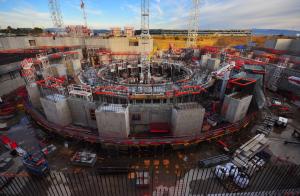But concrete pouring in a nuclear building is never routine, with each pour day marking the end of months of calculations, modellization and painstaking preparation.
For the ITER bioshield—the 3.2-metre-thick "ring fortress" surrounding the machine, whose role is to protect workers and the environment from the radiation generated by the fusion reaction—preparations have been particularly complex. Realizing a "perfect pour" for such a massive and strategic structure is so important that it was practised in a specially constructed full-scale mockup on the platform.
The density of the lattice of steel reinforcement makes the use of traditional concrete vibrators—used to encourage the concrete to reach every recess—impractical. As a consequence, an extra-fluid, self-compacting concrete was selected by the contractors and trialled in the on-site mockup.



